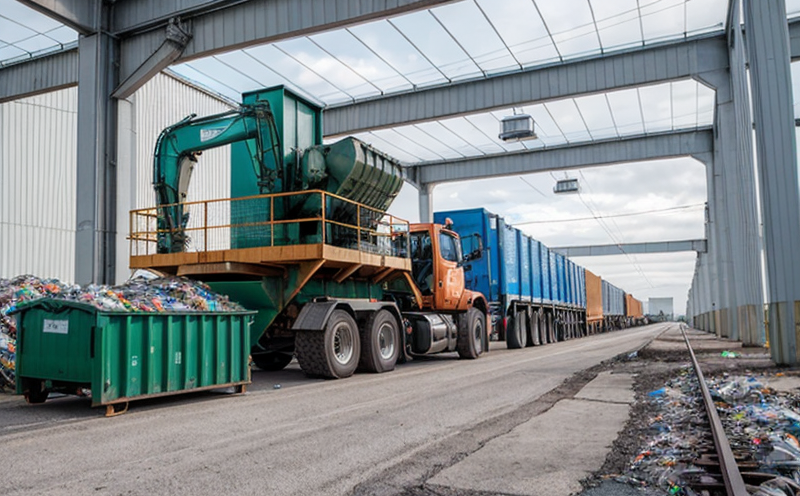ISO 17422 Plastics Environmental Aspects Testing in Recycling
The ISO 17422 standard is a critical pillar in environmental sustainability and waste management practices. It provides methodologies for determining the environmental aspects of plastics during recycling processes. This service ensures that manufacturers, recyclers, and suppliers can accurately assess the impact of plastic materials on the environment throughout their lifecycle.
The process involves several steps which are outlined in the standard. Initially, the material is sourced from end-of-life products or waste streams. The sample preparation phase includes cleaning, sorting, and shredding to ensure that only relevant material types are tested. This is crucial for obtaining accurate results as contaminants can skew the findings.
The testing itself involves a series of analyses aimed at quantifying the environmental impacts associated with plastic recycling. Key parameters include energy consumption during processing stages, emissions released into air, water, and soil, and the amount of waste produced throughout each stage of the recycling process. The use of advanced analytical techniques such as gas chromatography-mass spectrometry (GC-MS) and inductively coupled plasma mass spectrometry (ICP-MS) ensures precision.
The interpretation of these data points is essential for understanding how different plastics behave under various conditions. This information can inform improvements to recycling processes, leading to more efficient operations with reduced environmental footprints. Compliance with this standard not only benefits the immediate industry but also contributes positively towards global sustainability goals by promoting cleaner production methods.
For example, companies that comply with ISO 17422 may see reductions in carbon emissions or improved resource recovery rates from their recycling facilities. Additionally, stakeholders can use these insights to make informed decisions about which plastics are best suited for certain applications based on their environmental performance.
Implementing this standard also supports circular economy principles by fostering a closed-loop system where waste materials are reprocessed into new products instead of being discarded as landfill or incinerated. This reduces the demand for virgin raw materials while minimizing negative impacts on natural ecosystems.
| Test Parameter | Description | Methodology |
|---|---|---|
| Energy Consumption | Total energy required during processing stages including heating, cooling, and mechanical operations. | Measure using power meters and calorimeters. |
| Emissions | Variety of pollutants released into air, water, and soil during recycling processes. | Analyze using gas chromatography-mass spectrometry (GC-MS). |
| Waste Produced | Total mass of residual materials generated after processing. | Weigh samples before and after each step in the recycling process. |
In conclusion, ISO 17422 plays a vital role in ensuring that plastic waste is managed responsibly through efficient recycling practices. By following its guidelines, industries can significantly reduce their environmental impact while contributing to broader sustainability objectives.
International Acceptance and Recognition
- The ISO 17422 standard has been adopted by numerous countries worldwide due to its comprehensive approach to environmental assessments in recycling processes.
- Many leading international organizations, such as the European Union and United Nations Environment Programme (UNEP), recognize this standard for promoting sustainable practices within the plastics industry.
The widespread adoption of ISO 17422 is a testament to its relevance and effectiveness. It serves not only as a guideline for individual companies but also as part of broader governmental initiatives aimed at reducing plastic waste and encouraging circular economy models.
Environmental and Sustainability Contributions
The implementation of ISO 17422 contributes significantly to environmental protection by providing robust frameworks for evaluating the sustainability of plastics throughout their lifecycle. This includes assessing raw material sourcing, manufacturing processes, use phases, end-of-life management options, and recycling capabilities.
- Reduces reliance on virgin raw materials
- Minimizes greenhouse gas emissions during production and disposal
- Promotes efficient resource utilization through better design practices
- Supports policy development aimed at enhancing environmental stewardship
By adhering to these principles, businesses can demonstrate leadership in corporate social responsibility (CSR) efforts. They also position themselves favorably within competitive markets by offering eco-friendly products and services.
Use Cases and Application Examples
- Innovations in plastic recycling technologies
- Evaluation of new polymer blends for sustainability
- Development of extended producer responsibility programs
- Regulatory compliance audits for environmental standards
For instance, a company might use ISO 17422 to evaluate the environmental impacts of a newly developed polymer blend. By comparing pre- and post-processing data points such as energy consumption and emissions, they can determine whether there has been an improvement in sustainability.
| Case Study | Results |
|---|---|
| New Polymer Blend Evaluation | Significant reduction in greenhouse gas emissions compared to baseline material. |
| Extended Producer Responsibility Program Development | Improved recycling rates and reduced landfill contributions. |
These use cases illustrate how ISO 17422 can be leveraged across various stages of the plastics lifecycle to drive positive change. The standard provides a structured approach that helps companies make informed decisions about their environmental practices, ultimately contributing to global sustainability goals.





